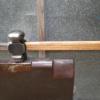A punch shears the sides of the hole, so the interior sides of the hole are more like a drilled hole [no matter what the shape: round, square, oval,slot,...], so when you drift the hole, the drift enters more efficiently. When you chisel the hole with a slitter, you get a more beveled hole witch is alot more resistant to a drift that is used to open up the hole to the desired shape. A chisel or slitting chisel only works when the material is backed or supported. The books say to chisel or slit 3/4 or 2/3 through the material and then turn it over and chisel or slit the rest of the way. Without backing or support a chisel or slitter cannot cut the material. It only stretches it until it can stretch no more and then finally pierces it.[metal is very resistant to stretching] That is why you will always see cold shuts in thicker metal that has been done with a chisel and slightly stretched metal when done on thinner stock. Punches solve this problem, and the punches shown in "Slitter Geometry" are much more efficient than flat punches because of the surface area contact with the material. I had Karen take a video of how I use a slot punch for thin stock, and here it is. If I had the technology to film the difference between chisels, flat punches, and these punches, anyone could see the difference. It is self evident. I know it is not conventional knowledge because it has not been written down yet in a book, but just try it and you will see for yourself.
http://www.youtube.com/user/brianbrazealblacksmi

